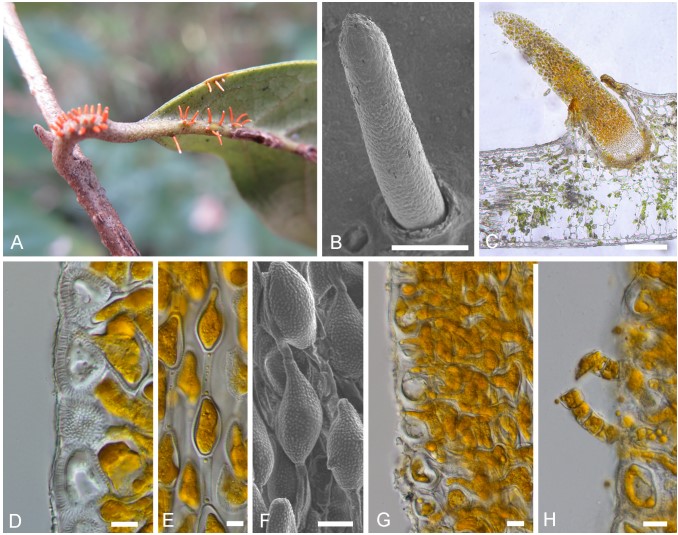Novopuccinia sycopsis-sinensis Y. Liu & Y. M. Liang, sp. nov. Figure 4
MycoBank number: MB 838357; Index Fungorum number: IF 838357; Facesoffungi number: FoF;
Typification: CHINA. Mt. Sanqingshan, Jiangxi Province, 28◦53r88rrN, 118◦04r57rrE, 1,340 m alt., April 1, 2017, on Sycopsis sinensis Oliv, coll. Y.M. Liang (Holotype: BJFC-R02976; Paratype: BJFC-R02983).
Etymology: Named after the host name of the type species.
Descriptions: Spermogonia, aecia, and uredinia unknown. Telia hypophyllous or petiolicolous, orange, hairlike columnar, exposed, and 2–5 mm long. Teliospores one-celled with elongated pedicel-like intercalary cells (25 µm long), ellipsoid to obovoid, 20–35 9–14 µm, and attenuate toward both ends; cytoplasm yellow; the wall colorless, 0.5–1 µm thick, and densely verrucose. Peridium cells rectangular to rounded, 20–31 18–23 µm; the wall colorless, 3–5 µm thick, and rough-surfaced.
Notes: N. sycopsis-sinensis can be easily distinguished from other similar taxa by elongated pedicel-like intercalary cells, one- celled, and peridium cells (Figure 4). According to Tranzschel’s law, the species has an endocyclic life cycle (Buriticá and Hennen, 1980; Buriticá, 1991).

FIGURE 4 | Morphology of Novopuccinia sycopsis-sinensis (BJFC-R02976, holotype). (A) Sori on a leaf and branches. (B) A teliospore, as seen by SEM. (C) Longitudinal section of a teliospore, as seen by LM. (D) Peridium cells, as seen by LM. (E) Teliospores, as seen by LM. (F) Teliospores, as seen by SEM. (G,H) Basidia as seen by LM. Scale bars: (B,C) = 1 mm; (D,H) = 10 µm.
